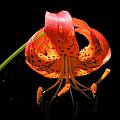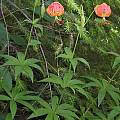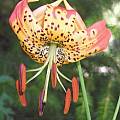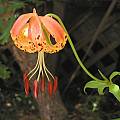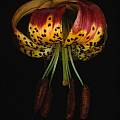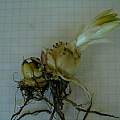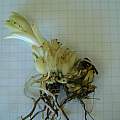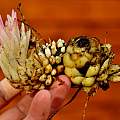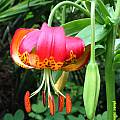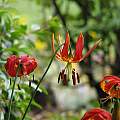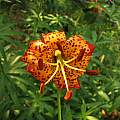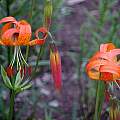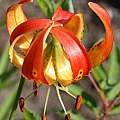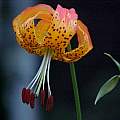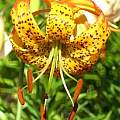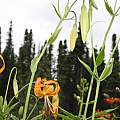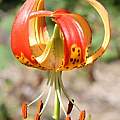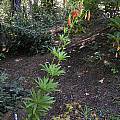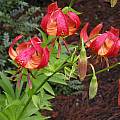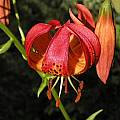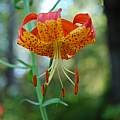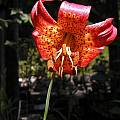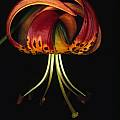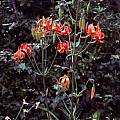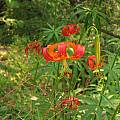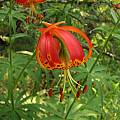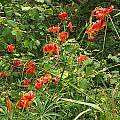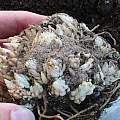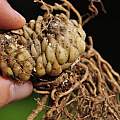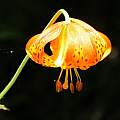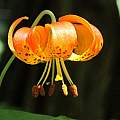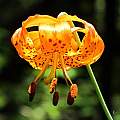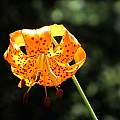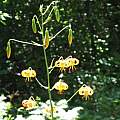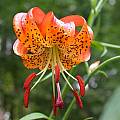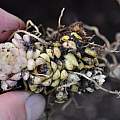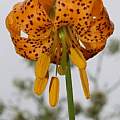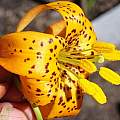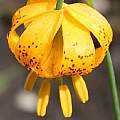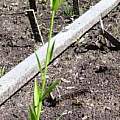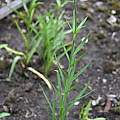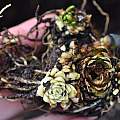Lilium pardalinum Kellogg is native to the Pacific Coast (southern Oregon to southern California.) It is a woodland species, often found growing near streams. Height: to 8 ft. The first four photos were taken by Bob Rutemoeller. The first three were taken July 2002 where it is growing near the Gualala River in California in exactly that habitat. The fourth photo shows it flowering around the same time growing in a large container. The fifth photo, by Ron Parsons, was taken of a plant in the wild, in Shasta County, California, July, 2006.
Photos 1 and 2 taken by Janos Agoston illustrate the bulb, which is considered a transition between a bulb and a rhizome. New bulbs grow from the lateral sides of the old bulb, enabling the plant to spread horizontally. Photo 3 by Pontus Wallstén.
Photos 1-2 from Jamie Vande are of a clone obtained in England. They are currently growing in a very compost rich soil in half sun, Cologne, Germany, Zone 8. Photos 3-5 were taken by Nhu Nguyen from the UCBG.
The following 6 photos by Darm Crook of plants grown in Hay River NWT, Canada.
Lilium pardalinum 'Giganteum', also known as 'Red Giant' or the Sunset lily was formerly known as Lilium harrisianum Beane & Vollmer. It has been treated as a large form of Lilium pardalinum or a hybrid between it and Lilium humboldtii. Beane and Vollmer described it from a wild population on the banks of Van Duzen Creek in northern California. It is very tall, from 5 to 7 feet with large beautiful flowers, 3-4 inches wide, that are gleaming carmine-red with brown spots. Unlike most other forms of L. pardalinum that usually form rhizomes which form multiple branches, that rebranch not just in one layer, but up and down as well, this plant forms one long rhizome with densely clustered masses around the main plant stem, all covered in scales. First three photos by Mary Sue Ittner. The last photo, by John Longanecker, is of a plant that was grown from seed in a pot in Placerville, El Dorado Co (El 2240' zone 7 banana belt) from seed gathered in El Dorado County.
Lilium pardalinum ssp. pitkinense (Beane & Vollmer) M.W.Skinner syn. Lilium pitkinense Beane & Vollmer is known from only two populations near Sebastopol, California. It is distinguished from the other taxa by smaller segments, elliptic leaves, red to orange-brown pollen, and magenta anthers. Height: 3-6 ft. The first two photos by Bob Rutemoeller illustrate the first bloom for one growing in a container. It is threatened by habitat loss, competition, and collecting. Photos #3-4 were taken by Ron Parsons of plants in cultivation.
The first three photos were taken by Nhu Nguyen at the UC Botanical Garden. The last photo of a bulb was taken by Pontus Wallstén.
Lilium pardalinum ssp. shastense (Eastw.) M.W.Skinner (syn. Lilium shastense (Eastw.) Beane, Lilium nevadense var. shastense) Eastw.) and also known as Shasta Lily is found in wet meadows and along streams in mixed evergreen forests. It occurs in the Sierra Nevada in Plumas, Butte, Trinity and Siskiyou counties north to Oregon. It flowers in summer. Height: 2-3 ft. Photo 1 from Ron Parsons. Photo 2 of a bulb by Pontus Wallstén.
Photographs below were taken by Rimmer de Vries at the locus classicus Mt. Shasta, CA in July 2010. The key thing about this plant that makes it different from the others is everything about the flower is flattened (shortened in the vertical dimension), flattened perianth, flattened anthers, etc.
Lilium pardalinum ssp. vollmeri (Eastw.) M.W.Skinner (syn. Lilium vollmeri Eastw.) grows along watercourses in Del Norte County, California and Josephine County, Oregon. It has unbranched rhizomes. Height: 3 ft. Photos 1 and 2 by John Lonsdale. Photo 3 by Ron Parsons from a population in the Siskiyou National Forest, Oregon. Photo 4 of a bulb by Pontus Wallstén.
Lilium pardalinum ssp. wigginsii (Beane & Vollmer) M.W.Skinner (syn. Lilium wigginsii Beane & Vollmer) is native to the Siskiyou Mountains in Northern California and southern Oregon where it grows at higher elevations. It has no bulb but instead it grows from a thick rhizome covered with small scales. This lily will grow up to 120 cm (4 feet) tall with whorled foliage. The florets are on long pedicels, pendent, fully recurved, yellow with purple to brown light to heavy spotting, and yellow pollen. The first photo below from Ron Parsons is from a wild population in Siskiyou County, California. Photos 2-6 are from Darm Crook.
Photos 1 and 2 below from Darm Crook who writes that in his zone 1 gardens it seldom exceeds 90 cm (3 feet). Photo 2 shows the stem of a juvenile plant, first flowering, before any whorls developed in later years. Photo 3 of a bulb by Pontus Wallstén.
Asiatic Section a-c - Asiatic Section d-k - Asiatic Section l-o - Asiatic Section p-z - Candidum Section - Dauricum Section - Martagon Section - Oriental Section - Trumpet Section - Lilium Hybrids - Lilium index - American Section a-m - American Section n-z -
